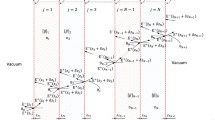Abstract
The polynomial approach has previously been proposed for modelling the optical response of electromagnetic waves propagating across lossless multilayer thin films when a voltage is applied. This study presents a comprehensive investigation of the propagation of electromagnetic plane waves in lossless, nonmagnetic multilayer thin films under the influence of external transverse voltage. The main objectives of this research are to analyse the optical response of thin films subjected to varying numbers of layers. The model involves introducing an external transverse potential to the multilayer thin films to evaluate the impact on the optical response. External voltage can provide a means to actively tune and control the optical properties of multilayer thin films. By applying a transverse voltage, it becomes possible to modify the reflectance, transmittance, and absorption spectra of the films. This ability to dynamically manipulate the optical behaviour opens up new avenues for designing reconfigurable and adaptive optical devices with versatile functionalities. In this present article, the optical responses of electromagnetic waves propagating through multilayer thin films fabricated from calcium fluoride and silicon dioxide are being modelled and generated using the WT code. Both CaF2 and SiO2 are lossless materials. CaF2 and SiO2, being largely different in resistivity, are expected to display an enhanced effect in the accumulation of charge at the interfaces of adjacent layers. Simulations are performed on the optical response of multilayer CaF2/SiO2 thin films subjected to a tuneable transverse potential. The model is computationally implemented in a MATLAB program written by the author, dubbed the Wave Tensor (WT) code. The study demonstrates that the WT code efficiently and reliably predicts the optical response of thin films containing alternating lossless-lossless materials. The optical responses are obtained for different numbers of thin film layers and at various values of external transverse potential. The results show that the impact of the thickness of layers is greater than that of applying transverse voltage. In other words, the effect of the propagation matrices is stronger than the interface matrices. The variance in resistivity of adjacent layers partially enhances the influence of the interface matrices when applying a transverse voltage, leading to more significant effects on the curves of reflections and transmissions. The significance of the obtained results lies in their potential applications in optoelectronic devices and Nano photonics. Understanding and controlling the optical properties of thin films under external electrical fields can enhance the performance of devices such as optical filters, waveguides, and photodetectors. Moreover, the findings contribute to the fundamental understanding of light-matter interactions in layered structures and offer insights into the design and optimization of future nanostructured systems (Malek in Opt Quantum Electron 55:196, 2023; Al-Dossari in Opt Quantum Electron 55:484, 2023; Aly in Ismail Polym Bull, 2023; Aly in Sci Rep 13:9422, 2023). This research elucidates the optical behaviour of multilayer thin films under external transverse voltage and establishes a foundation for further investigations in the field (Shabat in Phys Scr 67:147, 2003; Taya in Optik Stuttg 122:666, 2011). The outcomes contribute to both applied and fundamental aspects of thin film optics and pave the way for future advancements in develo** innovative optoelectronic devices and Nano photonic systems.





Similar content being viewed by others
References
C Malek, M Al-Dossari, S K Awasthi, M A Ismail, N S A El-Gawaad and W Sabra Opt Quantum Electron. 55 196 (2023)
M Al-Dossari, Z A Zaky, S K Awasthi and H A Amer Opt Quantum Electron. 55 484 (2023)
A H Aly, S A ldris, S K Awasthi, D Mohamed, N S A El-Gawaad, and M A Ismail Polym. Bull. (2023)
A H Aly, B A Mohamed, S K Awasthi and S A O Abdallah Sci Rep. 13 9422 (2023)
M M Shabat and S A Taya Phys. Scr. 67 147 (2003)
S A Taya and T M El-Agez Optik (Stuttg). 122 666 (2011)
M K M Elhabbash, M M Halim and T L Yoon Opt Quantum Electron. 55 214 (2023)
M K M Elhabbash and M M Halim Opt Quantum Electron. 53 1 (2021)
A Boukhari, B Deghfel, A Mahroug, R Amari, N Selmi and S Kheawhom Ceram Int. 47 17276 (2021)
H Kato, T Matsushita, A Takayama, M Egawa and K Nishimura J. Appl. Phys. 93 3906 (2003)
S A Taya and T M El-Agez Int. J. Microw. Opt. Technol. 7 135 (2012)
S A Taya, E J El-Farram and M M Abadla Optik (Stuttg). 123 2264 (2012)
S A Taya Opto-Electron Rev. 26 236 (2018)
S K Awasthi, R Panda, A Verma and P K Chauhan J. Phys. 94 1665 (2020)
Mikhail Polyanskiy. (n.d.). Refractive index of Silica - Silicon Dioxide (SiO2). https://refractiveindex.info/tmp/data/main/SiO2/Malitson.csv
LLC, M. (n.d.). LLC, MatWeb. https://www.matweb.com/
Filmetrics acquired by KLA company. (1995). Refractive Index of SiO2, Fused Silica, Silica, Silicon Dioxide, Thermal Oxide, ThermalOxide. https://www.filmetrics.com/refractive-index-database/SiO2/Fused-Silica-Silica-Silicon-Dioxide-Thermal-Oxide-ThermalOxide
Ure Jr, R. W. J. Chem. Phys. 26, 1363 (1957)
Mikhail polyanskiy refractive index of silica - silicon dioxide (SiO2), https://refractiveindex.info/tmp/data/main/SiO2/Malitson.csv
Author information
Authors and Affiliations
Corresponding author
Additional information
Publisher's Note
Springer Nature remains neutral with regard to jurisdictional claims in published maps and institutional affiliations.
Rights and permissions
Springer Nature or its licensor (e.g. a society or other partner) holds exclusive rights to this article under a publishing agreement with the author(s) or other rightsholder(s); author self-archiving of the accepted manuscript version of this article is solely governed by the terms of such publishing agreement and applicable law.
About this article
Cite this article
Elhabbash, M.K.M., Halim, M.M. & Yoon, T.L. Modelling the propagation of electromagnetic plane waves in lossless, nonmagnetic multilayer thin films using polynomial model. Indian J Phys 98, 1995–2003 (2024). https://doi.org/10.1007/s12648-023-02971-x
Received:
Accepted:
Published:
Issue Date:
DOI: https://doi.org/10.1007/s12648-023-02971-x




